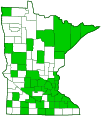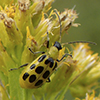spotted cucumber beetle
(Diabrotica undecimpunctata)
Conservation • Description • Habitat • Ecology • Distribution • Taxonomy
Conservation Status |
|
|||||||
| IUCN Red List | not listed |
|||||||
| NatureServe | NNR - Unranked |
|||||||
| Minnesota | not listed |
|||||||
Description |
||
Spotted cucumber beetle is a small skeletonizing leaf beetle. It occurs throughout the United States, in Mexico, and in southern Canada. It is common in Minnesota. It is found in fields, including agricultural fields. The larva feeds on the roots of corn, plants in the Cucurbitaceae (cucumber) family, and other plants. The adult feeds on the flowers, leaves, stems, and fruit of a more than 200 species of plants. As they feed they create holes in the leaves, scars on the stems, and pinholes on the fruit. They transmit bacterial and viral diseases. Spotted cucumber beetle is a vector for at least five plant diseases. It is a major pest to agricultural crops. Because of the wide variety of plants it damages it is considered one of the ten worst insect pests. The body is oval, 3⁄16″ to 5⁄16″ (4.6 to 7.7 mm) long, and ⅛″ (2.8 to 3.9 mm) wide. When viewed from above, the head and most of the legs are clearly visible. The head is black. The antennae are thread-like and long, more than half as long as the body. They have 11 segments. The first segment (scape), second segment (pedicel), and third segment (first flagelomere) are yellow. The remaining 8 segments are black. The antennae are close together at the base, about level with the middle of the eyes. They are flexible, and can project in various directions. The eyes are not notched. The exoskeletal plate covering the thorax (pronotum) is rectangular, wider than the head, and narrower than the base of the hardened wing covers (elytra). It is colored differently than the elytra, yellow to yellowish-red with no black markings. The elytra are greenish-yellow, hairless, and long, concealing the entire abdomen. They have a distinct, narrowly flattened margin. There are six bold black spots on each elytron. The plate between the wing bases (scutellum) is small, triangular, and black. The legs are mostly black. The base of the third leg segment (femur) is yellow. The last part of each leg (tarsus), corresponding to the foot, has five segments. However, the fourth segment is minute and is concealed within the heart-shaped lobes at the end of the third segment, making it appear that there are only four segments. The last segment has a pair of claws. |
||
Size |
||
Total length: 3⁄16″ to 5⁄16″ (4.6 to 7.7 mm) |
||
Similar Species |
||
Habitat |
||
Fields, agricultural fields |
||
Ecology |
||
Season |
||
April to October |
||
Behavior |
||
|
||
Life Cycle |
||
|
||
Larva Food |
||
Roots of corn, plants in the Cucurbitaceae (cucumber) family, and other plants. |
||
Adult Food |
||
Flowers, leaves, stems, and fruit of a wide variety of plants. |
||
Distribution |
||||
|
Sources |
|||
| 10/12/2022 | ||||
Occurrence |
||||
Common |
||||
Taxonomy |
|||
Order |
Coleoptera (Beetles) | ||
Suborder |
Polyphaga (Water, Rove, Scarab, Long-horned, Leaf, and Snout Beetles) | ||
Infraorder |
Cucujiformia | ||
Superfamily |
Chrysomeloidea (leaf beetles and allies) | ||
Family |
Chrysomelidae (leaf beetles) | ||
Subfamily |
Galerucinae (skeletonizing leaf and flea beetles) | ||
Tribe |
Luperini | ||
| Subtribe | Diabroticina | ||
Section |
Diabroticites | ||
| Genus | Diabrotica (cucumber beetles) | ||
Subordinate Taxa |
|||
spotted cucumber beetle (Diabrotica undecimpunctata howardi) western cucumber beetle (Diabrotica undecimpunctata tenella) western spotted cucumber beetle (Diabrotica undecimpunctata undecimpunctata) |
|||
Synonyms |
|||
|
|||
Common Names |
|||
southern corn rootworm (larva) spotted cucumber beetle (adult) |
|||
Glossary
Elytra
The hardened or leathery forewings of beetles used to protect the fragile hindwings, which are used for flying. Singular: elytron.
Femur
On insects and arachnids, the third, largest, most robust segment of the leg, coming immediately before the tibia. On humans, the thigh bone.
Pronotum
The exoskeletal plate on the upper side of the first segment of the thorax of an insect.
Scutellum
The exoskeletal plate covering the rearward (posterior) part of the middle segment of the thorax in some insects. In Coleoptera, Hemiptera, and Homoptera, the dorsal, often triangular plate behind the pronotum and between the bases of the front wings. In Diptera, the exoskeletal plate between the abdomen and the thorax.
Tarsus
On insects, the last two to five subdivisions of the leg, attached to the tibia; the foot. On spiders, the last segment of the leg. Plural: tarsi.
Visitor Photos |
|||||
Share your photo of this insect. |
|||||
| This button not working for you? Simply email us at info@MinnesotaSeasons.com. Attach one or more photos and, if you like, a caption. |
|||||
Alfredo Colon |
|||||
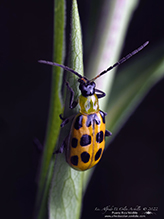 |
|||||
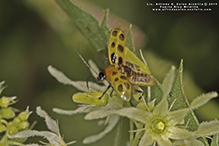 |
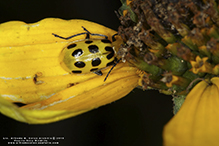 |
||||
Babette Kis |
|||||
Diabrotica undecimpunctata spotted cucumber beetle This common beetle is easily identified and a favorite among children due to its bright colors. Spotted cucumber beetle on dandelion Barnes Prairie 8 30 2021 |
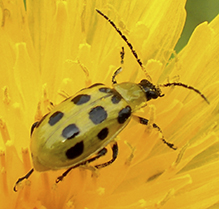 |
||||
Spotted cucumber beetle on goldenrod Barnes Prairie 10 5 2022 |
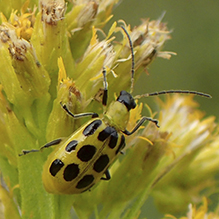 |
||||
Alfredo Colon |
|||||
 |
 |
||||
MinnesotaSeasons.com Photos |
|||||
|
|||||

Slideshows |
||

Visitor Videos |
|||
Share your video of this insect. |
|||
| This button not working for you? Simply email us at info@MinnesotaSeasons.com. Attach a video, a YouTube link, or a cloud storage link. |
|||
Other Videos |
|||


Created: 9/24/2020
Last Updated:
